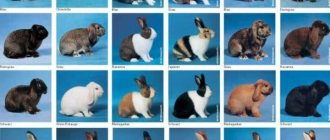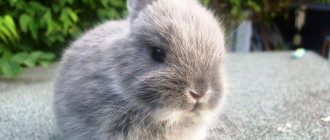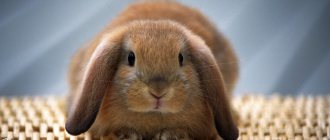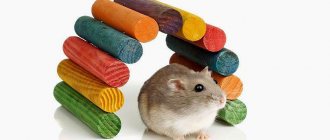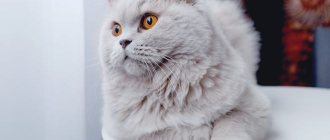Expert opinion
Dobryshev Sergey Anatolievich
Professional rabbit breeder and hare breeder with 30 years of experience
The purpose of decorative rabbits is clear from the name. Their calling is not to bring profit to their owners, but to bring joy with their mere presence. There is a wide variety of breeds of decorative rabbits. They differ in appearance, character, and size. There are breeds of animals that can be used both for breeding for the purpose of obtaining skins and meat, and as pets.
Various types of decorative rabbits allow you to choose this animal according to your taste and in accordance with your financial capabilities.
Why are decorative individuals needed?
For games
Their purpose is quite clear from the name. Decorative breeds are not intended for breeding for meat or skins. These babies are bred as pets. The variety of species allows each person to choose his favorite. Outwardly, these are cute and cute animals that have not only an attractive appearance, but also a special character.
Yes Yes. Decoratives have their own habits, their own fears or pleasures. These are calm but cheerful animals. They do not conflict and respond adequately to external stimuli. But there are also capricious species that require a special approach.
Keeping a pet
In order for an animal to feel comfortable in an apartment or house, it is necessary to take care of its place of “residence” in advance. For this purpose, a spacious cage is selected, which can be zoned into separate areas:
- for rest and sleep;
- for wakefulness;
- eating area, where a bowl for water and food is placed;
- toilet, where a special tray is placed.
Dutch
They got their name due to the place where they were bred - the Netherlands. A very peculiar breed, judging by its external color. The back of the body along with the paws have the same color as the ears and part of the muzzle. The unusual thing is that the color of these parts of the body is determined by the color of the eyes. They match. There are white “socks” on the bottom of the hind legs; the rest of the body is white. If we look at the rabbit from the side, the body is “half-shaped” in color contrast.
It is considered ancient; similar images date back to the 15th century. Official sources state that the breed appeared only in the mid-19th century.
The behavior cannot be called anything other than cute. They are affectionate and sympathetic to children. They easily get used to a person and communication with him. The weight of the rabbit is about 2-2.2 kg, any color (back part and ears with a muzzle). In total, a little more than 20 types of colors are recognized (shades of brown, sand, gray, black, blue).
Downy breeds
Angora, this is also the name of this breed. Even though only one breed was exported from Turkey and found its way to France, it was only in the 19th century that Angoras began wandering around the world. The standard was created very long and carefully - the breed has changed a lot to the present day. The length of the coat, weight, appearance - everything has stood the test of time. And as they say, times change and we change with them. At the moment, the weight of the angora according to the standard reaches from 2 to 6 kg. The Angora's coat contains down interspersed with protective guard hair. Just like the Angora goat. The Chinese will rub anyone's nose in the rabbit fur category, and that's a plus.
Breeding pets with such fur is their pride. Removing fluff from an Angora's body is not easy. You can wait for the molting period, but this happens only 2 times a year. But cutting it is much easier and more profitable: you can collect fluff for the whole year. A trimmed Angora rabbit resembles a pocket dog with tassels instead of ears. This is quite an entertaining spectacle for the owner and a release of ballast for the pet.
In domestic downy rabbits, the most common color is white, but other fur colors are also available. The Angora needs careful care. Frequent cleaning of the cage, hairdressing services, exciting games - all this is quite troublesome. But if you decide to take this particular breed, don’t hesitate. The animal is quite cheerful and playful. When an Angora goes for a walk, it is better to put all precious breakable objects away.
Advice! When buying a rabbit, monitor the baby's behavior. Calmness and indifference when picked up can mean poor health or illness. Ask the breeder to share with you photos of the pets' names. If the breeder works officially and has experience, then he will certainly share with you photographs of the baby rabbit’s mother, tell you at what age she gave birth to him, and also share any interesting information from the life of the pet you want to buy.
Shorthaired Dwarf (Colored Dwarf)
This is a very small rabbit, its weight ranges from a kilogram to one and a half. The length of the ears is only 5.5 cm. Regarding the color, it is difficult to name a specific color. In total, there are about 6 dozen colors of this species.
The body is quite small, but it is quite strong. The legs and neck are short compared to other ornamental breeds. The rabbit's coat is soft and shiny. The length of the coat is insignificant, hence the name shorthair. The most popular color is pure white. The white Oto color is popular; in this case, there is one black spot on the pure white body. It frames the eye, has a smooth shape without protrusions or interruptions. Chinchilla, brown, black, blue, sand and other colors are common.
By their nature, they rarely show aggression. The only time you may notice an unreasonable manifestation of this emotion is puberty. At such a moment, the rabbit may bite. After a few months, the aggression disappears.
Normal behavior: curiosity, activity. They are small in size and beautiful in appearance.
Reproduction
The pregnancy of a female dwarf breed lasts from 29 to 32 days. In one litter she brings from 3 to 7 rabbits. When the babies are 2 weeks old, they begin to climb out of the nest on their own. The young are separated from their mother at the age of two months.
Newborns require special care. They must be protected from direct sunlight, wind, dust, and high humidity.
Dutch Fold
The main distinguishing feature of this breed: hanging ears. We are accustomed to the fact that baby rabbits have protruding ears, but in the lop-eared category we bypassed this criterion.
The Dutch Fold's ears are not very long, so they do not drag on the ground, unlike the English. The muzzle of this rabbit is not elongated and the ears look organic. Of all the lop-eared varieties, the Dutch are the smallest.
The behavior is non-aggressive, the animals are very active, but without unnecessary fuss.
conclusions
Summing up the decorative breeds of rabbits, it is worth once again highlighting important points when choosing a breed:
- In total, there are more than 200 types of decorative rabbits, but when purchasing from the seller, there must be a pedigree for the animal indicating the breed and parents.
- Dwarf breeds weigh a maximum of 2 kg, and the length of the ears does not exceed 6 cm.
- Each variety of eared animals has its own character, and before purchasing a pet, you should carefully study this aspect in order to avoid unpleasant surprises.
- Long-haired species require regular brushing and removal of pellets. In addition to such care, it is also worth regularly vaccinating your rabbit - which and when to do is described here.
- Rabbits cannot tolerate loud sounds or bright lights. This can cause them to lose their appetite and get sick.
Also read about the dwarf breed - the fold-eared Ram.
Dwarf ram
Rabbits have medium length fur. This species belongs to the fold-eared category.
They belong to large decorative breeds, their weight reaches 3 kilograms. They have a stocky body, a beautifully defined back line, and short legs. The back of the body is rounded. The name ram comes from the shape of the head. She has a wide forehead and large eyes, resembling the head of a ram. The wool is soft with undercoat. Various shades of color.
Not very active, very calm. What is noteworthy is that they are practically not afraid of anything, unlike others. Quickly gets used to human society. Unpretentious in content.
Features of rabbit biology
But many people mistakenly believe that rabbits are domesticated hares. This is wrong. Although rabbits belong to the lagomorph family, they are different animals, and therefore they need different care.
Moreover, wild and domestic rabbits are not rodents. Their differences are in the shape of their teeth, and in the structural features of the stomach, and in their lifestyle.
There are also differences between rabbits and hares:
- hares are much larger;
- they have long hind limbs, which allows them to jump several meters;
- rabbits build holes (and last a lifetime), and hares build nests;
- a female rabbit bears offspring for 30 days, a female hare - 45;
- Rabbits are blind for 7 days and only suck milk until 21 days, and rabbits are born sighted and begin to graze from 2-3 days.
The question of how long decorative rabbits live at home is most often of interest to animal lovers who are planning to get rabbits.
The data is:
- the brown hare lives 6-7 years;
- white hare – 4-5 years;
- wild rabbit – 9 years;
- The lifespan of decorative rabbits can reach 12 years.
Fox dwarf
The main feature of foxes is their long hair. The head has short hair, the rest of the body is covered with abundant hair, the length of which is from 4 to 7 millimeters. The body is stocky, the neck is almost invisible. There is a curly, but short head.
The ears are closely erect, stand straight, have a rounded shape at the ends, the average length is 5.5 cm. The maximum possible length of the ears is 7 cm. The front legs are disproportionately short.
Average weight 1.3 kilograms. The most common colors are three types: brown, agouti, chinchilla. Other shades are also acceptable. The constitution is somewhat similar to the Hermelin breed. Experts do not agree on the temperament of rabbits. Some people come across calm individuals, while others come across restive ones. But their opinion is unanimous on one thing: fox rabbits need careful care.
Breeding and its subtleties
Rexes do not have good fertility abilities. The female gives birth to only 4-6 cubs. At the slightest failure to comply with the conditions, the babies quickly die. Therefore, animals require reliable protection and care.
02:36
Breeding Rex rabbits as a business idea | Rex Rabbits
10:19
Rabbits of the Rex breed, description of the breed.
16:53
Breeds REX, FLANDERS AND GIANT. All the intricacies of rabbit breeding. Breeding rabbits.
In terms of external features, Rex cubs are not distinguished by their beauty; they even look unsightly. The offspring acquire characteristic thoroughbred features as they grow up.
It is not necessary to be present near the mother in labor during the birth of the rabbits. However, during the first birth, the rabbit needs to be accompanied by the process. The future nurse of her offspring may not prepare the nest. Such behavior in frequent cases causes the sudden death of rabbits. In order to prevent such an outcome, the owner of the farm must provide the female with a large amount of water before lambing.
So that the babies can safely feed on mother's milk, it is recommended that the expectant mother develop nipples before giving birth, otherwise the babies can cause severe pain to the first-born mother and cause anger.
Small representatives of Rex need to be looked after more seriously. If the behavior of the mother rabbit towards the cubs is negligent, support for the further growth and existence of the offspring should be provided in the form of a suitable temperature regime. You can install a lamp in the cage as a heat source.
During the autumn cold weather, creating a nest will help. If you feed newborn Rex properly, the babies are more likely to survive. In the absence of natural mother's milk, the babies are nursed using artificial formulas or placed with another lactating female.
Condensed milk or a special mixture is often suitable as a replacement for natural milk. The cubs need to be fed once a day for 21 days. When the kids grow up, they are switched to a plant-based diet.
It is quite difficult for new rabbit breeders to provide proper care during breeding. In order for the offspring to survive and grow fully, additional consultation with a professional will be required.
Signs of culling
If the animal is stroked against the grain, the fur is elastic and elastic and immediately returns to its original position. When this does not happen, the purity of the breed raises some doubts.
If a rabbit weighs less than 2 kg and more than 5 kg , this is another sign of culling. Such individuals are not suitable for procreation. The same applies to passive and lethargic animals, since it is possible that they are sick. Other signs of culling Rex rabbits:
- drooping, thin ears;
- bald patches on the body;
- fur length more than 2.4 cm;
- presence of a double or triple chin;
- ear length more than 13 cm;
- poor hair development.
Lion head
It got its name from the mane that frames its head. It has a long body but short ears. The length of the coat does not exceed an average of 6, maximum 7, centimeters. Some varieties have black rims around the eyes. There are no special criteria for colors; they can be varied. Difference: small size, low weight, noticeable difference in the length of the hair between the entire body and the head.
Has a very friendly character. Get it if you have small children. Affectionate, has a phlegmatic temperament. Happy to take part in children's games. Does not require special conditions for maintenance. Unpretentious. I don't mind walking on a leash.
Angora dwarf
It can easily be confused with an ordinary ball of fur. Because of this feature of the coat, it is difficult to see the eyes or nose. It's all about the long fur. It covers the entire area of the rabbit's body, and the fur on its face is especially thick. If you decide to pet an Angora rabbit, you will feel pleasant and soft fur under your hand. It feels like cotton wool to the touch.
There is one variety of Angora decorative type. These animals have shorter fur and are easier to care for. It tangles less. The coat of this breed is smooth and shiny. No more than 5 cm in length.
The body of Angora pets has a cylindrical shape. The head is round, the eyes are shallow-set, the neck is barely noticeable. The ears are short, barely peeking out from behind the fur.
The whole difficulty of caring for Angora rabbits is grooming. Fur requires constant attention. It needs to be combed thoroughly and regularly. If you miss the moment and the fur still gets matted, there is no need to injure the rabbit and try to comb out this lump. Trim any matted fur immediately.
Angora lion
The rabbit has the longest hair. It is present on the ears, which is quite unusual for rabbits. There is less hair on the muzzle than on the rest of the body. If you notice that the fur has begun to fall over the rabbit’s eyes and is preventing him from looking, then the hair needs to be cut. A common lion color is reddish-brown.
This decorative species has a calm disposition. They do not show causeless aggression. Not fussy, but does not welcome excessive activity.
Pygmy hare
One of the most common breeds among domestic animals. The body is proportional, slightly elongated torso. There are no special features in the constitution; in the complex the rabbit looks organic. Distinctive color: white body, on which there are dark (black, blue, brown) inclusions. The same color, ears, tail, paws. What is noteworthy is that the spots appear after birth. The eyes are red.
Hermelin
Many rabbit breeders, especially inexperienced ones, call it a decorative Polish species. For some reason, this pet did not become very popular in Russia, but in Scandinavia and Great Britain it became widely known. The average weight is one kilogram, but occasionally one and a half kilogram individuals can be found.
Color: pure white. The coat should not have a yellowish tint; this breed is snow-white, like snow. The eyes are either red or blue.
The body has a regular, proportional shape. They look quite elegant. The belly is tucked up, the head is large, shaped like an egg. The ears are thin and stand up. The length of the fur does not exceed 2 millimeters. The fur fits tightly to the body. The ears are short. Feature: button nose. Therefore, the muzzle is constitutionally reminiscent of the face of a Persian cat.
They are very afraid of the heat, which is why they have taken root in the Scandinavian countries.
The character is very unique. You don't know what they will do next minute. It is difficult for new rabbit breeders to cooperate with such individuals. Hermelins are unpretentious in care and nutrition.
Dwarf butterfly
It is rightfully called one of the most popular in Russia. Even residents of our country who are far from breeding rabbits know what the Butterfly rabbit looks like.
Rabbits are very small in weight, their average weight reaches 1.5 kilograms. The body has the shape of a cylinder. The body is strong, the back line is almost straight, the bend is barely noticeable. The croup has a rounded shape. the head is large. The ears are set close. The ears have a non-pointed, rounded shape at the ends. The Butterfly's claws are transparent.
If we consider the Butterfly’s fur, it must be shiny, this is one of the signs. The most common color for this species is white. Deviations are acceptable, but a symmetrical pattern is required.
The answer to the question: “why are they called butterflies?” It's all in the drawing. The black wide rims around the eyes are closed. The ears are completely colored black, and there are dots on the cheeks of the same color. Small “wings” are present at the corners of the mouth. What is noteworthy is that on the ears the dark color turns into an even stripe along the spine. There are 4-6 black spots on the sides. If you notice spots on the chest, belly or paws, then this is a defect.
Squirrel
This type of rabbit is very similar to a squirrel, hence the name. Average in weight and size. It was bred at the beginning of the 20th century, so it is relatively young. We got these cuties in Germany.
They have a proportional body, strong. The back is wide. An adult weighs about 4 kilograms, small deviations are acceptable. The belly and lower part of the tail are lighter in color than the rest of the body. The head is small, the eyes are gray.
It is not popular in Russia, but has already found its fans in other countries of the world.
There are noticeable differences in this list of breeds. Regardless of your desires, you can choose the rabbit that suits you. And remember one rule: no matter what type of pet rabbit you have, you cannot pick it up by the ears.

